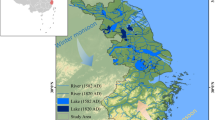Abstract
Locusts and grasshoppers have caused periodic devastations since the very beginning of recorded history and are a threat worldwide until this very day. The most feared of all locusts was (and is) the desert locust,Schistocerca gregaria (Forsk.) (’arbeh’). This review deals with different aspects of man’s interaction with this pest in the Mediterranean and Near East regions as reflected by ancient literature: decorations found in Egyptian tombs (6th Dynasty, 2420-2270 B.C.), in the Har-ra=Hubullu list (Assyria — the Ashurbanipal Royal Library, 669-626 B.C.) and in Biblical, Rabbinical, Greek and Roman literature. The aspects covered herein are those of locust nomenclature, terms used for the development stages (life cycle), outbreaks, plagues and their consequences (famine), locusts as food, etc. Some control measures during Biblical, Grecian, Roman, Mishnaic, Talmudic, Byzantine and modern times (19th and 20th Centuries) are reviewed. Nowadays, the total area invaded during desert locust outbreaks and plagues extends over 29 million square kilometers of desert and subdesert, involving more than 60 nations. Between plagues the ’natural’ locust population occupies an area of approximately 14 million square kilometers of desert and subdesert.
An attempt is made to identify various terms for locust in the pre-Biblical, Biblical, Rabbinical, Greek and Roman literature according to modern nomenclature.
Similar content being viewed by others
References
Aharoni, I. (1916) [The Locust.] Jaffa. (in Hebrew) [cited in Bodenheimer (8, 10)].
Aharoni, I. (1938) On some animals mentioned in the Bible.Osiris 5:475–476.
A.I.D. (1987) Environmental Health and Safety — Fundamental to Development. A.I.D. Special Report. Washington, DC. pp. 23-29.
Ascher, K.R.S. (1987) Notes on Indian and Persian lilac pesticide research in Israel.Proc. 3rd Int. Neem Conf. (Nairobi, Kenya, 1986), pp. 45-53.
Avidov, Z. and Harpaz, I. (1969) Plant Pests of Israel. Israel Universities Press, Jerusalem.
Avigad, N. (1966) A Hebrew seal with a family emblem.Isr. Explor. J. 16:50–53.
Beavis, I.C. (1988) Insects and Other Invertebrates in Classical Antiquity. Exeter Univ. Publ., Devon, UK.
Bodenheimer, F.S. (1935) Animal Life in Palestine — An Introduction to the Problem of Animal Ecology and Zoography. Sefer Publ., Tel Aviv, Israel, pp. 349–355.
Bodenheimer, FS. (1944) Studies on the Ecology and Control of the Moroccan Locust (Deciostaurus maroccanus) in Iraq. Govt. of Iraq, Directorate-General Agric. Bull. 29.
Bodenheimer, F.S. (1960) Animal and Man in Bible Lands. Brill, Leiden, the Netherlands.
Cloudsley-Thompson, J.L. (1979) Insects and History. Weidenfeld and Nicholson, London, UK.
Efflatoun Bey, H.C. (1929) The development of entomological science in Egypt.Trans. 4th Int. Congr. Entomology (Ithaca, NY, 1928), Vol. 2, pp. 737-742.
FAO (1995) Desert Locust Control Committee. Report of the Thirty-Third Session. FAO, Rome, Italy.
FAO (1995) Emergency Center for Locust Operations. Desert Locust Bull. No. 201, Rome, Italy.
Feliks, Y. (1971) Locust.in: Encyclopedia Judaica. Keter Publ. House, Jerusalem, Israel. Vol. 11, pp. 422–424.
Feliks, Y. (1992) [Nature and Land in the Bible.] Reuven Maas, Jerusalem, Israel (in Hebrew).
Garnsey, P.F. (1988) Famine and Food Supply in the Graeco-Roman World. Cambridge Univ. Press, Cambridge, UK.
Harpaz, I. (1973) Early entomology in the Middle East.in: Smith, R.F. [Ed.] History of Entomology, pp. 21–37. Annual Review Inc., Palo Alto, CA, USA.
Hedin, S. (1918) Jerusalem. Leipzig, Germany. pp. 106–112 [cited in Bodenheimer (8)].
Hort,A. (Ed. and Trans.) (1916-26) Theophrastus: Enquiry into Plants. Loeb Classical Library, London, UK.
Isman, M.B. and Cohen, M.S. (1995) Kosher Insects.Am. Entomol. 41(2):100–102.
Kohlenberger, J.R. III (1987) The Interlinear NIV Hebrew-English Old Testament. Zondervan Publ. House, Grand Rapids, MI, USA.
Landsberger, B. (1934) Die Fauna des Alten Mesopotamiens nach der 14 Tafel der Serie Harra=Hubullu. Hirzel, Leipzig, Germany.
Needham, J. (1956) Science and Civilisation in China. II. History of Scientific Thought. Cambridge University Press, Cambridge, UK.
Nevo, D. (1992) Pests and Diseases of Agricultural Crops and Their Control in Erez Israel during the Biblical and Mishna Periods. Ph.D. thesis, Bar-Ilan University, Ramat Gan, Israel (Hebrew, with English summary).
Nevo, D. (1995) Some diseases of agricultural crops and their control in the Land of Israel during Biblical, Mishnaic and Talmudic times.Phytoparasitica 23:7–17.
Palmoni, I. (1972) [Locust.]in: Biblical Encyclopedia. Vol. I, pp. 520–526. Mosad Bialik Publ., Jerusalem (in Hebrew).
Peck, A.L. (1965-70) Aristotle:Historia Animalium. Vols. 1 and 2. Loeb Classical Library, London, UK.
Rackham, H. and Janes, W.H.S. (Ed. and Trans.) (1947-63) Pliny: Natural History. Loeb Classical Library, London, UK.
Ramme, W. (1951) Zur Systematic, Faunistic und Biologie der Orthopteren von Sudost-Europa und Vorder-Asien.Mitt. Zool. Mus. Berl. 27.
Scholfield, A.F. (Ed. and Trans.) (1958-59) Aelian: On the Characteristics of Animals. Loeb Classical Library, London, UK.
Shpan-Gabrielith, R. (1968) [Desert Locust.] Ministry of Agric, Plant Protection Dept., Tel Aviv, Israel (in Hebrew).
Shrewsbury, J.F.D. (1970) A History of Bubonic Plague in the British Isles. Cambridge Univ. Press, Cambridge, UK.
Uvarov, B.P. (1966) Grasshoppers and Locusts. A Handbook of General Acridology. Vol. 1. Cambridge University Press, Cambridge, UK.
Uvarov, B.P. (1977) Grasshoppers and Locusts. A Handbook of General Acridology. Vol. 2. Centre for Overseas Pest Research, London, UK.
Whiting, J.D. (1915) Jerusalem’s Locust Plague.Natl. Geogr. Mag. 28:511–550[cited in Bodenheimer (8, 10)].
Author information
Authors and Affiliations
Additional information
Excerpt from the Ph.D. thesis: ‘Pests and Diseases of Agricultural Crops and Their Control in Erez Israel during the Biblical and Mishna Periods’, Bar-Ilan University, Ramat Gan, Israel.
Rights and permissions
About this article
Cite this article
Nevo, D. The desert locust,Schistocerca gregaria, and its control in the land of israel and the near east in antiquity, with some reflections on its appearance in Israel in modern times. Phytoparasitica 24, 7–32 (1996). https://doi.org/10.1007/BF02981450
Received:
Issue Date:
DOI: https://doi.org/10.1007/BF02981450
Key Words
- Desert locust, Schistocerca gregaria
- outbreak, plagues, recession, upsurge, solitary phase, gregarious phase, transient phase
- plant pests
- Bible
- Rabbinical sources
- Mishna
- Babylonian Talmud
- Jerusalem (Palestinian) Talmud
- Halakhah
- Midrash (Aggadah)
- Greek and Roman literature
- Sumerian and Akkadian sources
- Land of Israel
- Near East




